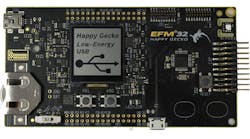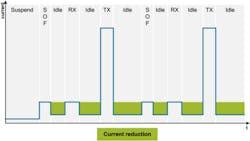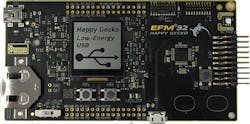Silicon Labs’ 32-bit, Cortex-M0+ Happy Gecko (Fig. 1) is designed to minimize power requirements across the board. It includes a crystal-less, low energy USB interface making it ideal for energy sensitive applications. It has a range of energy management modes plus a 6-channel Peripheral Reflex System (PRS) that allows autonomous inter-peripheral communication even when the processor is in sleep mode. The PRS allows the output of one peripheral to trigger another. This includes the 6-channel DMA. The chip also includes an array of ultra-low power digital and analog peripherals.
The 25 MHz Happy Gecko has up to 64 Kbytes of flash and 8 Kbytes of RAM. In addition to the USB interface, the chip has a pair of high-speed USARTs with SPI and SmartCard support. There is also a low-energy UART that works with PRS and can run autonomously when the processor is in deep sleep mode. The I2C interface has SMBus support. The system also has a USB and UART bootloader plus a 2-wire serial debug interface.
On the analog side, there is a 12-bit, 1 Msample/s ADC. It has four single channels or two dual differential channels plus an on-chip temperature sensor. There is a current DAC that can deliver 0.05 to 64 µA. There is an analog comparator and capacitive touch sensing that handles up to five inputs.
The USB interface is designed to reduce USB power consumption by up to 80% with its Low Energy Mode (LEM) operation. LEM takes advantage of the idle time to reduce the interface’s power consumption (Fig. 2). It incorporates the PHY and interface resistors reducing the overall bill-of-materials (BOM). The USB interface has an integrated 5 V LDO. It also has dedicated RAM for end points reducing memory access overhead.
The chip has a fast wake-up time that is under 2 µs. This allows the PRS to quickly wake up the processor when needed. Programmers can choose the required memory and peripherals for the different power modes. For example, sleep mode uses 900 nA with the real-time-clock (RTC) and SRAM retention.
Silicon Labs understands that security is critical to embedded applications. The hardware AES subsystem can handle 128-bit keys in only 54 clock cycles.
Silicon Labs provides software developers with the Simplicity Studio IDE based on Eclipse. The IDE also includes Simplicity Designer and the Energy Profiler. Simplicity Designer supports the chip’s ability to remap I/O pins. The Energy Profiler helps track application energy usage so developers can optimize power requirements.
Simplicity Studio works with the SLSTK3400A Happy Gecko Starter Kit (Fig. 3). It has an integrated Segger J-Link USB debugger. There is a memory LCD and capacitive touch buttons as well as an on-chip humidity/temperature sensor.
The chip comes in a TQFP48 package. The supply voltage is 1.98 to 3.8 V DC.




